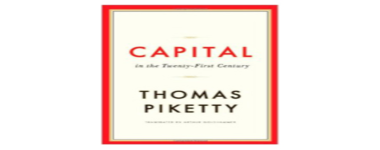Thomas Piketty, a 42-year-old economist from French academe has written a hot new book: Capital in the Twenty-First Century. The U.S. edition has been published by Harvard University Press and, remarkably, is leading the best seller list; the first time that a Harvard book has done so. A recent review describes Piketty as the man “who exposed capitalism’s fatal flaw.“

So what is this flaw? Supposedly under capitalism the rich get steadily richer in relation to everyone else; inequality gets worse and worse. It is all baked into the cake, unavoidable.
To support this, Piketty offers some dubious and unsupported financial logic, but also what he calls “a spectacular graph” of historical data. What does the graph actually show?
The amount of U.S. income controlled by the top 10 percent of earners starts at about 40 percent in 1910, rises to about 50 percent before the Crash of 1929, falls thereafter, returns to about 40 percent in 1995, and thereafter again rises to about 50 percent before falling somewhat after the Crash of 2008.
Let’s think about what this really means. Relative income of the top 10 percent did not rise inexorably over this period. Instead it peaked at two times: just before the great crashes of 1929 and 2008. In other words, inequality rose during the great economic bubble eras and fell thereafter.
And what caused and characterized these bubble eras? They were principally caused by the U.S. Federal Reserve and other central banks creating far too much new money and debt. They were characterized by an explosion of crony capitalism as some rich people exploited all the new money, both on Wall Street and through connections with the government in Washington.
We can learn a great deal about crony capitalism by studying the period between the end of WWI and the Great Depression and also the last 20 years, but we won’t learn much about capitalism. Crony capitalism is the opposite of capitalism. It is a perversion of markets, not the result of free prices and free markets.

